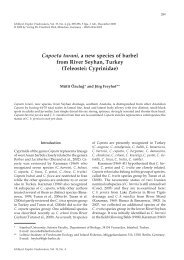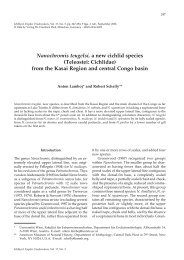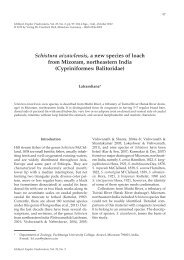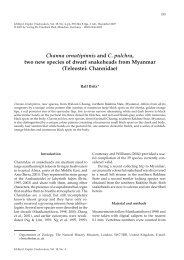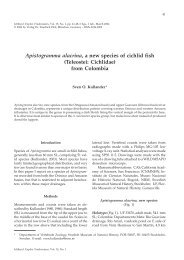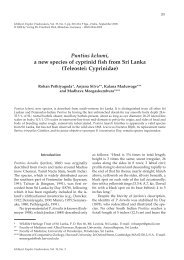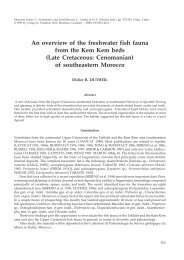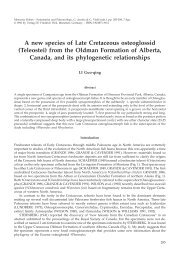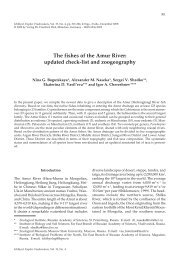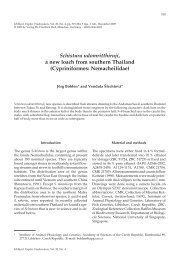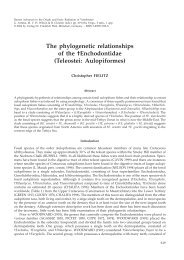A synopsis of the South Asian fishes referred to Puntius - Verlag Dr ...
A synopsis of the South Asian fishes referred to Puntius - Verlag Dr ...
A synopsis of the South Asian fishes referred to Puntius - Verlag Dr ...
You also want an ePaper? Increase the reach of your titles
YUMPU automatically turns print PDFs into web optimized ePapers that Google loves.
82<br />
<strong>Puntius</strong>. Our results also corroborate <strong>the</strong> phylogenetic<br />
relationships recovered by Bossuyt et al.<br />
(2004) involving some <strong>of</strong> <strong>the</strong> same species and<br />
analysing <strong>the</strong> same ~ 590 bp segment <strong>of</strong> <strong>the</strong> 16S<br />
rRNA gene and a ~ 540 bp segment <strong>of</strong> <strong>the</strong> cyt-b<br />
gene.<br />
None <strong>of</strong> <strong>the</strong> genus-group names hi<strong>the</strong>r<strong>to</strong> in<br />
<strong>the</strong> synonymy <strong>of</strong> <strong>Puntius</strong> have type species potentially<br />
referable <strong>to</strong> <strong>Puntius</strong> s. s., Sys<strong>to</strong>mus s. s.,<br />
Dawkinsia, <strong>Dr</strong>avidia or Pethia. The only contending<br />
genus-group names are Cephalakompsus Herre,<br />
1924a, Mandibularca Herre, 1924a, Ospatulus Herre,<br />
1924b, and Spratellicypris Herre & Myers, 1931,<br />
all <strong>of</strong> which have type species endemic <strong>to</strong> <strong>the</strong><br />
Philippines. These possess both rostral and maxillary<br />
barbels, by which <strong>the</strong>y are immediately<br />
distinguished from <strong>Puntius</strong>, Dawkinsia and Pethia<br />
(which lack rostral barbels). <strong>Puntius</strong> and Sys<strong>to</strong>mus<br />
are in any event not threatened by Cephalakompsus,<br />
Mandibularca, Ospatulus and Spratellicypris, which<br />
are junior. On <strong>the</strong> basis <strong>of</strong> <strong>the</strong> original descriptions<br />
<strong>of</strong> <strong>the</strong>ir type species in Herre (1924a), <strong>Dr</strong>avidia<br />
differs from Cephalakompsus, Ospatulus and Spratellicypris<br />
by having a smooth (vs. serrated) last<br />
unbranched dorsal-fin ray; and from Mandibularca<br />
by its smaller size (up <strong>to</strong> 80 mm <strong>to</strong>tal length,<br />
vs. 220 mm in Mandibularca), having <strong>the</strong> lower<br />
jaw horizontal (vs. strongly curved upwards) and<br />
habitus (see Herre, 1924a: pl. 1).<br />
<strong>South</strong> <strong>Asian</strong> <strong>Puntius</strong>. The recognition <strong>of</strong> additional<br />
genera within <strong>Puntius</strong> as previously unders<strong>to</strong>od<br />
makes it imperative that <strong>the</strong> identity <strong>of</strong><br />
P. sophore (Hamil<strong>to</strong>n, 1822), <strong>the</strong> type species <strong>of</strong><br />
<strong>Puntius</strong>, be stabilised. Hamil<strong>to</strong>n’s description and<br />
figure <strong>of</strong> P. sophore do not allow this species <strong>to</strong> be<br />
unambiguously distinguished from o<strong>the</strong>r valid<br />
species, e. g., P. chola, P. dorsalis. No type specimens<br />
<strong>of</strong> <strong>fishes</strong> described by Hamil<strong>to</strong>n have come<br />
<strong>to</strong> light in <strong>the</strong> 190 years since <strong>the</strong> publication <strong>of</strong><br />
this work; nor has <strong>the</strong> existence <strong>of</strong> such types<br />
been alluded <strong>to</strong> in <strong>the</strong> subsequent literature. They<br />
must <strong>the</strong>refore be presumed lost. Hamil<strong>to</strong>n (1822)<br />
did not specify <strong>the</strong> type locality <strong>of</strong> S. sophore in<br />
his account <strong>of</strong> that species, but it can be inferred<br />
from his preceding account <strong>of</strong> <strong>Puntius</strong> that it was<br />
Bengal. We selected ZRC 35064, a 71.8 mm SL<br />
specimen, as neotype because it was collected<br />
within <strong>the</strong> Ganges floodplain in Bengal (now<br />
Bangladesh); it is consistent with <strong>the</strong> original<br />
description (Hamil<strong>to</strong>n, 1822: pl. 19, fig. 86); and<br />
it is accompanied by a series <strong>of</strong> five <strong>to</strong>potypes<br />
that facilitate a more representative description.<br />
The coloration <strong>of</strong> <strong>the</strong> neotype also matches<br />
that deliniated in a copy <strong>of</strong> Hamil<strong>to</strong>n’s figure in<br />
<strong>the</strong> archives <strong>of</strong> <strong>the</strong> Linnean Society <strong>of</strong> London<br />
(Fig. 2b). This illustrates a specimen with 17 lateral-line<br />
scales, 2 unbranched and 8 branched<br />
dorsal-fin rays, 2 unbranched and 6 branched<br />
anal-fin rays, 1 + 7 + 7 + 1 principal caudal-fin rays,<br />
and 1 unbranched and 7 branched pelvic-fin rays.<br />
Although, as pointed out by Silva et al. (2010),<br />
Hamil<strong>to</strong>n’s drawings contain many inaccuracies<br />
in <strong>the</strong>ir detail, <strong>the</strong> neotype matches Hamil<strong>to</strong>n’s<br />
figure in general appearance. Based on <strong>the</strong> neotype<br />
and <strong>to</strong>potypes described herein, P. sophore<br />
may be distinguished from P. chola by <strong>the</strong> characters<br />
given in Talwar & Jhingran (1991) and<br />
Jayaram (2010), and from P. dorsalis by <strong>the</strong> characters<br />
given in Pethiyagoda et al. (2008).<br />
Because <strong>of</strong> a lack <strong>of</strong> material, we have been<br />
unable <strong>to</strong> assign several o<strong>the</strong>r Indian species with<br />
40 or more lateral-line scales, hi<strong>the</strong>r<strong>to</strong> in <strong>Puntius</strong>,<br />
<strong>to</strong> any <strong>of</strong> <strong>the</strong> above genera: <strong>the</strong>ir generic placement<br />
must depend on future work. Perhaps most<br />
prominent among <strong>the</strong>se are ‘P.’ deccanensis, ‘P.’ fraseri,<br />
and P. sharmai, which lack rostral barbels but<br />
possess a pair <strong>of</strong> maxillary barbels, a stiff, strongly<br />
serrated last unbranched dorsal-fin ray, and<br />
42-47 lateral-line scales, though <strong>the</strong> first species<br />
differs from <strong>the</strong> latter two by having 9 branched<br />
dorsal-fin rays and 7 branched anal-fin rays, vs.<br />
8 and 5 in <strong>Puntius</strong> (Hora & Misra, 1938; Yazdani<br />
& Babu Rao, 1976; Menon & Rema Devi, 1993).<br />
Also with a high lateral-line scale count (43) is<br />
<strong>Puntius</strong> punjaubensis (Day, 1871), which has no<br />
barbels and possesses a smooth last unbranched<br />
dorsal-fin ray: it is almost certainly not a member<br />
<strong>of</strong> any <strong>of</strong> <strong>the</strong> preceding genera. We note in passing<br />
that <strong>the</strong> original spelling ‘punjaubensis’ is not<br />
a lapsus for ‘punjabensis’, <strong>the</strong> spelling adopted in<br />
<strong>the</strong> current literature (e. g., Jayaram, 1991, 2010;<br />
Talwar & Jhingran, 1991): Day retained <strong>the</strong><br />
original spelling also in his ‘Fishes <strong>of</strong> India’ (1878),<br />
‘Punjaub’ having been an accepted contemporaneous<br />
spelling.<br />
Ano<strong>the</strong>r intriguing taxon is ‘<strong>Puntius</strong>’ ophicephalus,<br />
for which Menon (1999) created <strong>the</strong><br />
genus Eechathalakenda. Possessing both maxillary<br />
and rostral barbels, a smooth last unbranched<br />
dorsal-fin ray and 40-42 lateral-line scales, this<br />
species does not fit within any <strong>of</strong> <strong>the</strong> preceding<br />
genera. Menon (1999) diagnosed Eechathalakenda<br />
from Gonoprok<strong>to</strong>pterus by its “elongated Channa<br />
like appearance, 7 branched rays in <strong>the</strong> dorsal fin<br />
(9 in Gonoprok<strong>to</strong>pterus), a slightly elongated but<br />
Pethiyagoda et al.: Synopsis <strong>of</strong> <strong>South</strong> <strong>Asian</strong> <strong>Puntius</strong>





